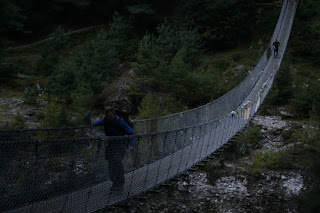By Karina Gallant
Two days ago, we arrived in Lukla
at what’s known as the most dangerous airport in the world. There is really no
margin for error. The landing strip is only slightly longer than a commercial
airplane, and drops off a steep cliff on takeoff. Fortunately, we were all much
too distracted by our first clear view of the mountains to fear the landing, and
we all made it in one piece. While the Sherpas strapped about 140 pounds each
of our luggage onto their backs, we relaxed in a coffee shop and enjoyed a
pastry before setting off through town behind scores of other trekkers.
 |
| Dave dances on a suspension bridge |
I stumbled along in awe of the
beauty that I would soon become accustomed to, trying to take in the culture
and the view all while not tripping over my feet. The fresh mountain air was a
great relief from the smog and pollution of Kathmandu, and the calm steady hike
and beautiful scenery was enough to distract from the thinning air and rapid
elevation gain. The trek to Monjo—our camp that night—weaves through small
villages, along cliffs and grey rivers and past prayer wheels and Sherpas carrying
more than their weight with a strap on their heads. It’s a descent from about
9,000 feet in Lukla to 8500 in Monjo. We arrived at our lodge at tea time, and
soon after, Anette brought out a bottle of scotch that her poor Sherpa had hauled
up the mountain. This quickly became a theme at tea time and dinner, a slight
escape after a day of working hard.
We began our promised steep ascent
with eyes on the Bridge of Sighs, the most notable suspension bridge on the
trek so far. It rose high above the river and was covered in hundreds of prayer
flags flapping in the wind. Soon, our climbing was rewarded with our first
glimpse of Everest, its significance more exciting than the mountain itself.
The further we travelled from the villages, the more I was reminded of home. If
it wasn’t for the prayer flags and enormous mountains, it wouldn’t take much to
convince me I was in the North Cascades. The towns we did see were a mix of old
and new—many houses utterly destroyed by the earthquake, but many lodges and
restaurants standing well.
 |
| Home destroyed by earthquake |
I bounded ahead chatting with our
guide about his family and mine, and took pictures of every cat, dog, yak, and
mountain that I saw. Finally, Namche Bazar was in view, a terraced village set
in the hill. It is much like the others we’ve seen but on a much larger scale.
Tents, lodges, and shabby homes are placed randomly around patches of land
where zoes graze and crops grow. Mountains rise above on every side, and the
edge of the town drops off into a deep valley. A monastery lies up above the
village, surrounded by construction projects and rocky trails. We spoke to a
woman, Nawang, who runs a dental clinic here, and many of her young patients
skip around the boarding school in their matching uniforms.
Currently, Clark and Jes are hiking
towards a nearby hospital. Dave, Anette, and Claus are shopping for more
supplies, because Namche is our last chance before Phortse. I managed to secure
a free day, and am sitting on a rock with at least five different mountains
surrounding me, and a baby zoe grazing nearby. Seeing these grand mountains on
such a close scale awakens a mountaineering desire I never knew I had.
Hopefully it won’t be long before I’m back here standing on top of one of the snowcapped
peaks. Tomorrow we will ascend to Phortse with Mingma to begin our project,
assuming we can find all the materials.
 |
| View of Namche Bazar |
No comments:
Post a Comment